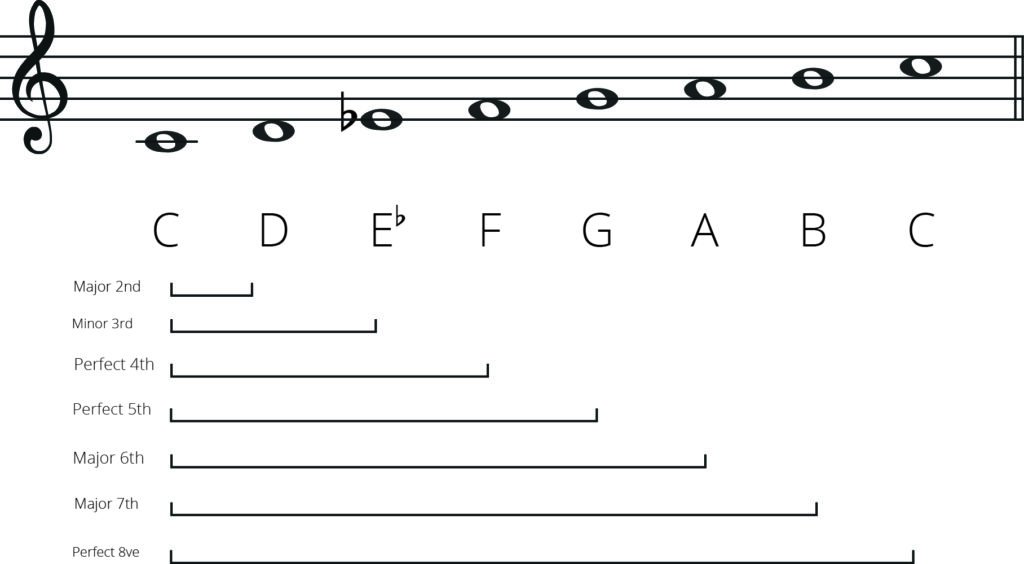Minor scales sound very different to major scales because they are based on a very different patterns of intervals. As we have seen before there are actually three different types of minor scale, the natural minor scales, the harmonic minor scales and the melodic minor scales.
A minor scale shares its key signature with the relative major scale. To know more about the relative keys and their key signatures make sure to check out our blog post on the circle of fifths and key signatures. Scales and their different relationships to each other is a very important topic within music theory and is well worth ensuring you understand well. In this blog post we will look at the melodic minor scale in detail. However, before we can look too much in detail at the melodic minor scale we must briefly discuss both the natural minor scale and the harmonic minor scale.
The natural minor scale
The natural minor scale is essentially the major scale but starting on a different note. The pattern of tones and semitones in a natural minor scale are:
Tone, Semitone, Tone, Tone, Semitone, Tone, Tone
The e natural minor scale would therefore follow this pattern:
E, F#, G, A, B, C, D, E
Notice how the e natural minor scale has an F#. E minor is the relative minor to G major.
The natural minor scale is the same ascending as it is descending. Natural minor scales are a great place to start when learning about the minor scale as they help to strengthen your knowledge of the relationship between major and minor keys.

[thrive_leads id=’12684′]
The harmonic minor scale
The harmonic minor scale is also essentially the major scale starting on a different note, but with one key difference! When we ascend and descend in the harmonic minor scale, we must also raise the seventh note!
The pattern of tones and semitones in a harmonic minor scale are:
Tone, Semitone, Tone, Tone, Semitone, Tone and a half, Semitone
The e harmonic minor scale would therefore follow this pattern:
E, F#, G, A, B, C, D#, E
All harmonic minor scales follow this same pattern.
Now here is for the minor scale you have been waiting for. The melodic minor scale.

ToneGym- The Ultimate Ear Training App
ToneGym allows you to improve your ear with a range of games, interactive and competitions.
Or check out our complete review of ToneGym.

the melodic minor scale
Melodic minor scales are a little different to both the natural minor scale and the harmonic minor scale. The melodic minor scale is different ascending and descending. This is very different to the other minor scales where they are the same on the way up as they are on the way down.
To achieve a melodic minor scale you must raise both the sixth and seventh on the way up and then on the way down these will be lowered. As you can see the ascending melodic minor scale is different to the descending scale.
The pattern of tones and semitones for the ascending form of the melodic minor scale is as follows:
Tone, Semitone, Tone, Tone, Tone, Tone, Semitone
Whole step, half step, Whole step, Whole step, Whole step, Whole step, half step
Let’s take a look at the ascending c melodic minor scale.
C, D, Eb, F, G, A, B, C

Now lets look at the descending melodic minor scale
C, Bb, Ab, G, F, Eb, D, C

Descending melodic minor scales are exactly the same as the natural minor scale! Or the same as it’s relative major scale but starting on a different note.
This distinction between the ascending and descending versions of melodic minor scales is respected in classical music theory but in other genres such as jazz theory, when we refer to the melodic minor scale we are simply referring to the ascending version of the scale.
[thrive_leads id=’12684′]
The pattern of intervals in an ascending melodic minor scale are:
Major 2nd, minor 3rd, Perfect fourth, Perfect fifth, Major sixth, Major seventh, Perfect Octave

Understanding intervals so important as it will allow you to move between major and minor scales easily. We have a basic guide to intervals if you feel like brushing up on this topic.
Knowing these can help you to build chords – to know more about chord and how they are built make sure to check out our blog on chords and our blog on seventh chords.
ToneGym- The Ultimate Ear Training App
ToneGym allows you to improve your ear with a range of games, interactive and competitions.
Or check out our complete review of ToneGym.

Why do we use the melodic minor scale?
We use the melodic minor scale is used most usually when we write melodies! Due to the sixth and seventh notes being raised it creates a different sound that can make beautiful melodies.
You can hear examples of the melodic minor scale in action in these popular songs
Yesterday – The Beatles
You can hear the melodic minor scale starting from its fifth scale degree. Make sure to listen out for the lyrics ‘All my troubles seem so far away’.

What are the chords/triads we can build over a melodic minor scale?
The triad qualities in a melodic minor scale?
Chord i – minor
Chord ii – minor
Chord III – augmented
Chord IV- Major
Chord V -Major
Chord vio – Diminished
Chord viio – Diminished
If we apply this to the C melodic minor scale:
Chord i – C, Eb, G
Chord ii – D, F, A
Chord III – Eb, G, B
Chord IV – F, A, C
Chord V – G, B, D
Chord vio – A, C, Eb
Chord viio – B, D, F

By understanding how to build chords over each of the scale degrees you will be very equipped to create chord progressions for the melodies you write using a melodic minor key!
The melodic minor scale can add extra depth and excitement to the pieces you compose.
[thrive_leads id=’12684′]
